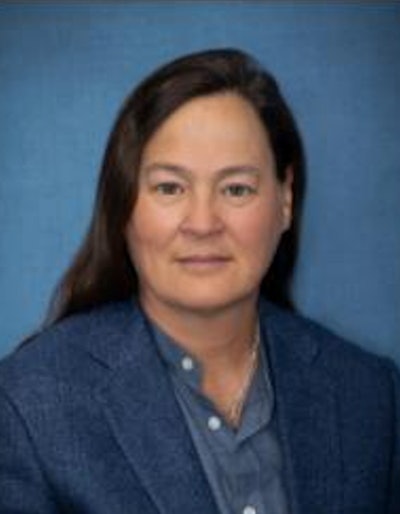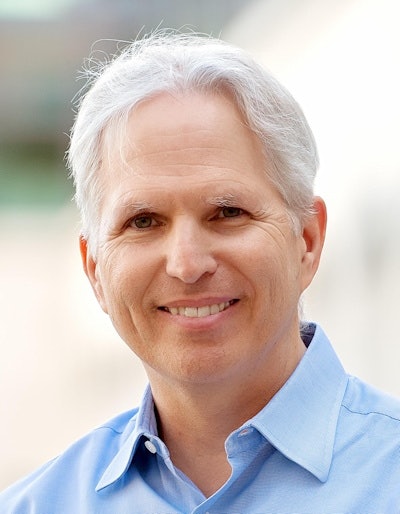
Radiology practices are harnessing new technologies, such as novel workflow software and artificial intelligence (AI), to automate workflow, enabling radiologists to use their time more efficiently and potentially lessening their stress.
 Dr. Elizabeth Bergey.
Dr. Elizabeth Bergey.Radiologists are faced with interpreting hundreds of exams per day, and imaging volumes are increasing as scanners become more efficient. Practices are also confronted with a shortage of radiologists exacerbated by COVID-19 burnout.
"Radiologists, even with the best intentions, have found it hard to determine which is the best study to read next," said Dr. Elizabeth Bergey, CEO of Quantum Imaging and Therapeutic Associates in Lewisberry, PA, an independent private practice radiology group. "So what you need now is a 'computer brain' that can look at the big picture, including one that indicates what type of study it is, how long it takes to read, and when the study is going to expire."
There are too many questions for radiologists to answer and too many issues for them to deal with for any individual to assess what is in the best interest of the entire practice, according to Bergey.
"Enterprises have become too complex to have workflow directions or guidelines that can be followed to optimize the workflow and the performance of the enterprise," she said. "You need software that can look at the big picture and determine the needs of the enterprise."
 Dr. Anthony Agbay.
Dr. Anthony Agbay.Dr. Anthony Agbay, also of Quantum Imaging, noted that in some instances, companies will have many different radiologists scattered over the state or country, each using their own methodology to determine which cases they should be reading next.
"So there's a substantial amount of time required to select cases, especially when you consider that some radiologists will read 100 cases to 150 cases a day," he said. "You multiply that by at least five seconds of decision-making each time, and it eats up quite a bit of your day. Cherry-picking studies can add half an hour to an hour of time. If you multiply that by 70 radiologists, it's actually quite substantial."
Cherry-picking occurs because the work relative value unit (wRVU) is a poor reflection of a radiologist's true work effort and productivity measure, according to Agbay.
"There are discordances in the wRVU credit with some CPT codes, such as PET scans, noncontrast chests, and thyroid ultrasounds that lead to cherry-picking around these cases," he said. "There are also specific case discordances since radiologists are not afforded a case complexity modifier, so older patients, babies, cancer follow-ups, and others are undervalued by CMS credit systems. We can't use wRVU to compare apples to apples. Cherry-picking artificially increases the production of the picker and undervalues the contribution of those who are reading the picked-over cases."
Intelligent workload management
To improve radiologist workflow, Quantum and GE Healthcare have partnered to market an intelligent workload management software solution based on Quantum's Helix Balance software. Helix Balance is an intelligent orchestration engine that combines patient history, physician performance and abilities, clinical priority, and real-time exam volume to optimize radiologists' workflow across the entire practice.
In addition, Quantum and GE market Helix Pace, which adjusts productivity targets based on exam complexity and historical performance trends, helping physicians optimize their workload and RVU output.
Quantum also offers Helix Path, which integrates into diagnostic workflows to ensure that clinically relevant information from radiology reports is appropriately managed within a health system, according to the company. Quantum also markets these products on its own.
"The business has become so complex. It's not a little shop with a few radiologists anymore. With the internet and teleradiology, it's become many times more complex," added Bergey. "We need help improving our (the practice's) overall efficiency such that we can have an effective staff. The efficiency gains can result in clinical, operational, and financial improvement."
Functionality
Generally, radiologists look for a certain amount of functionality in workflow tools. This includes feeding cases to radiologists that are within their skill set, according to Agbay.
"As a radiologist, I want to make sure I'm being fed cases in my skill set," he said. "Our technology is sophisticated enough to do that. If I do not read pediatric head ultrasounds, I can essentially deem that to be outside of my skill set, and the software will never feed one of those cases to me again. You can set the parameters to whatever threshold you want."
Adding to the functionality, cases can be prioritized however the organization's radiologists want.
"We know what the estimated reading times of the studies are," Bergey said. "We know how many people are signed up to read at a moment in time, and we make decisions on how many and which radiologists need to attack a list based on very objective metrics. So we can call in extra help exactly when and only if we need to."
From a user perspective, there are times, especially in the off-hours, overnights, and weekends, when radiologists historically use their subjective judgment on whether they need to make a phone call because they're getting swamped, Agbay noted. Of course, different people have different thresholds.
"There's no homogeneity when we're doing it based on a feeling," Agbay said. "But when we can use a mathematical formula to calculate exactly when the currently signed-on radiologists truly are getting behind, that takes the decision-making out of it."
That subsequently decreases radiologist stress, Agbay added.
"They don't have to wrestle with whether they have to burden their partners to help on their day off," he said. "This capability can help with burnout because we won't have to worry about constantly checking how far behind we are. We don't have the stress from looking at the length of a list. Rather, we can focus on the job at hand."
Regarding workload balance, Bergey said, "If you have every radiologist read the same amount of studies, then you're going to have the faster radiologists doing less while the slower radiologists catch up. And that effectively decreases the overall productivity of your enterprise, costs more, and degrades performance. We are constantly improving our algorithms and are already seeing significant improvements for individuals and the practice as a whole, which is exciting."
Bergey and Agbay believe a better metric for gauging performance would be time instead of RVUs. Accurately and fairly calculating the estimated time it should take a radiologist to interpret a specific study allows the practice to quantify the amount of work a given radiologist should contribute in an apples-to-apples way. This levels the playing field and promotes physician satisfaction and performance.
AI addressing stress
Meanwhile, AI is also finding ways to help reduce radiologist stress. Northwell Health is using AI to improve the detection of findings and for triage to prioritize which studies should be read first because they may have positive findings, according to Dr. David Hirschorn, chief of informatics for the imaging service line at Northwell Health.
 Dr. David Hirschorn.
Dr. David Hirschorn."One of the earliest focuses of AI is on critical findings," Hirschorn said. "These are the ones that you don't want to miss. AI provides a second way of seeing these critical things. AI is helping radiologists catch important findings that are time-sensitive and a high priority in some studies where there was no indication before the study was done that there might be a critical finding."
This relieves a lot of stress among radiologists who are concerned that they might miss an important finding.
"AI can also decrease the radiologist workload by taking routine chores off their hands," Hirschorn added. "We may not be there yet, but when we get to the stage where we can offload plain vanilla chest x-rays to an AI algorithm to be read, and not have a human look at them, then that can definitely decrease radiologist burnout."
Integration challenge
Although Hirschorn sees few issues with implementing AI, more challenging to him is its actual integration into the workflow to make it practical and useful to radiologists. Many vendors suggest putting the results from AI algorithms into the PACS. But Hirschorn believes that that information does not have to be part of a patient's permanent medical record, and that radiologists would be better served if an algorithm's results are placed in a practice's workflow orchestrator, an automation tool that prioritizes work and which is becoming more of a necessity as workloads become heavier and more complex.
A workflow orchestrator could automatically indicate that a case has high priority and must be read immediately.
"A PACS is meant to display pixels," Hirschorn said. "It's not meant to prioritize cases. That's for the workflow orchestrator to do."
Another option for placing AI results would be in an independent desktop widget, a piece of software that's being developed by Northwell Health, according to Hirschorn. It would give a radiologist a popup alert indicating a specific finding from a study requires attention.
 Dr. Greg Zaharchuk, PhD.
Dr. Greg Zaharchuk, PhD.Dr. Greg Zaharchuk, PhD, a professor of radiology at Stanford University, concurs with Hirschorn that AI can reduce some stress for radiologists by taking routine chores off their hands, including measuring discrete lesions such as lung nodules or brain metastases.
"While these measurements are extremely important for patient care, they are very tedious and do not require high levels of clinical training. AI could assist with these jobs and free up radiologists to interpret other studies," Zaharchuk said. "This would make AI both functional and practical for improving radiologist workflow."
But integrating AI into a system can be a challenge, according to Zaharchuk, as many AI vendors offer only a single or a few software algorithms, which may not be compatible with other AI software.
"The key is to get these products to work in harmony so that AI can be integrated in a way that does not make the radiologist's life more difficult," he said.
Downstream
Zaharchuk believes that downstream "image interpretation" AI applications would most naturally exist as extensions to the PACS.
"It is natural for downstream AI to live either in the PACS or on a platform of AI apps that integrates very tightly to the PACS, which would make it extremely functional for radiologists," he said.
Zaharchuk said that AI may have a role to play to enable better distribution of studies to different radiologists, especially if a practice is trying to balance the workload among radiologists spread over several sites, where some radiologists are specialists.
Quantum's Helix Balance facilitates the integration of multiple disparate systems and consolidates multiple PACS into one, according to Bergey. Then once all exams are in one place, Balance distributes cases to available radiologists so that the performance of the enterprise is optimized, radiologists' strengths can be maximized, and their performance best measured, Bergey said.
Eventually, Zaharchuk predicts that AI will be allowed to review studies autonomously -- without a second review by radiologists, which also will reduce their stress and burden.
"While this will not happen overnight, I believe there will come a time when some fraction of our studies will be read autonomously by AI," Zaharchuk said. "Right now, maybe 30% of studies are normal. If an algorithm could be developed that could identify a normal study with a very high confidence level, human radiologists may no longer need to review that study. If you eliminated the need to read these cases, resources could be freed up to double-read other studies or spend more time on more complex studies."
Issues
But Hirschorn notes that there also may be issues with AI.
"If AI is too sensitive and raises too many false-positive readings, it can actually slow us down," Hirschorn said.
It might also create a liability issue if a radiologist sees a suspicious finding that an algorithm flagged and decides not to follow up on it, believing that it is not an issue or that to do so would be a waste of medical resources, he said.
While there may be technical challenges to implementing AI, Zaharchuk sees its cost of implementation as a significant challenge as well.
"Using AI in applications like load balancing might be helpful to reduce stress on radiologists," Zaharchuk said. "But to enable widespread adoption, it will be key to show that AI can improve radiologists' productivity and patient outcomes, which may be difficult to show."
Those who make purchasing decisions in radiology practices can be very far removed from clinical work, Zaharchuk noted.
"They'll ask, 'Why would I prioritize this software to make my radiologists happy when they're doing the job now, and I have other pressing financial needs?' " Zaharchuk said. "One potential motivation for a practice to invest in AI software may be to help with recruitment and retention of its staff in an increasingly competitive hiring environment."
Despite concerns, novel technologies are poised to change the radiology workplace potentially for the better by generating new efficiencies and relieving radiologists of a good deal of stress.



















